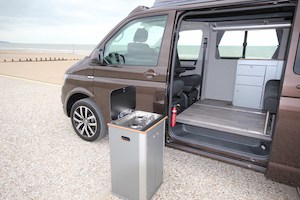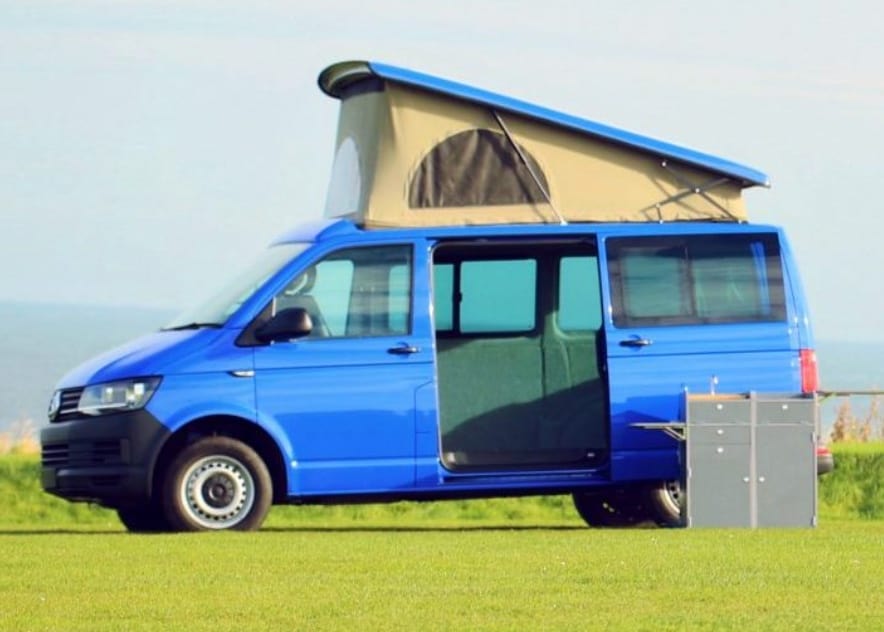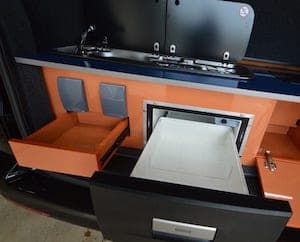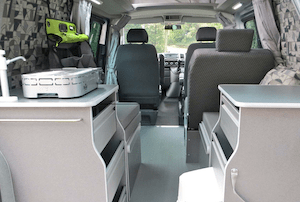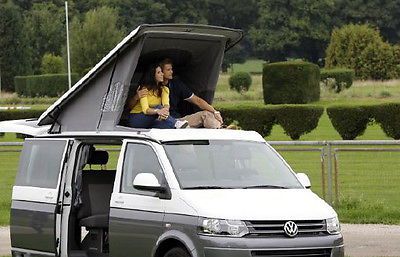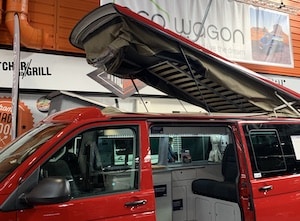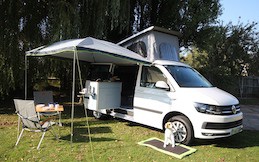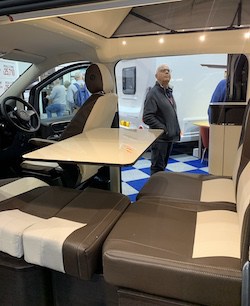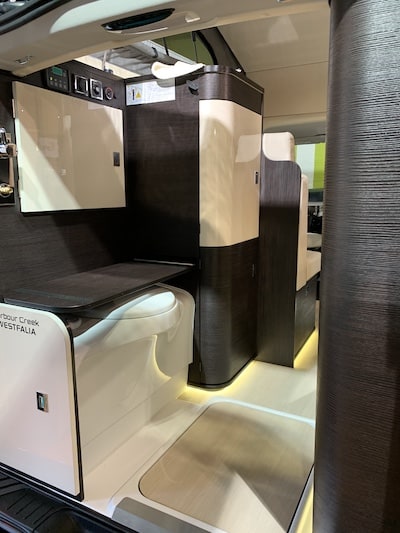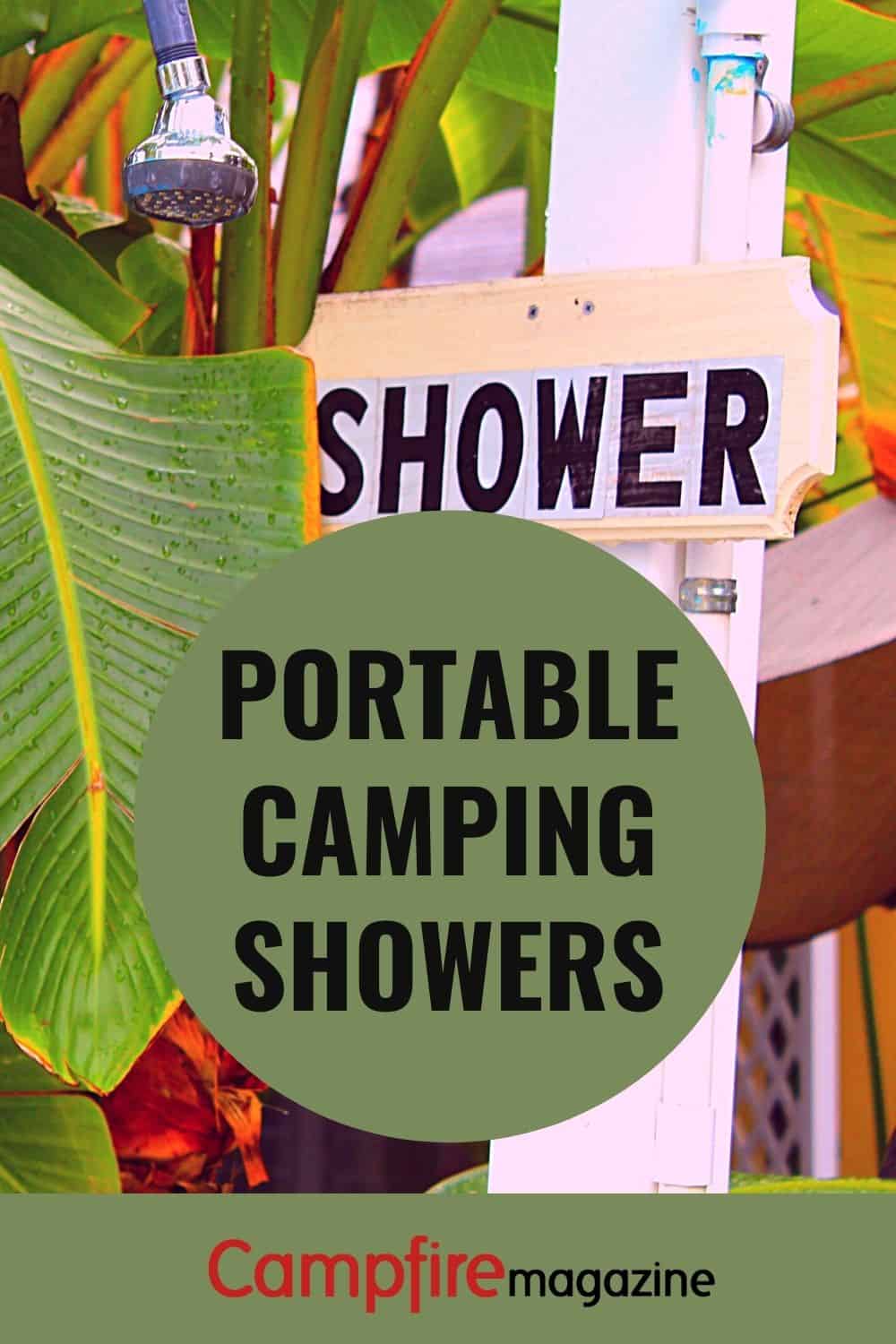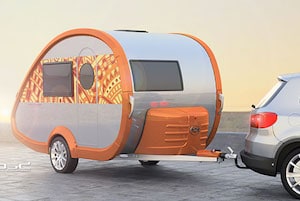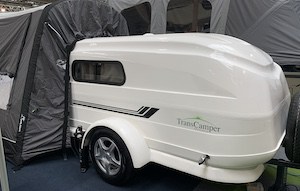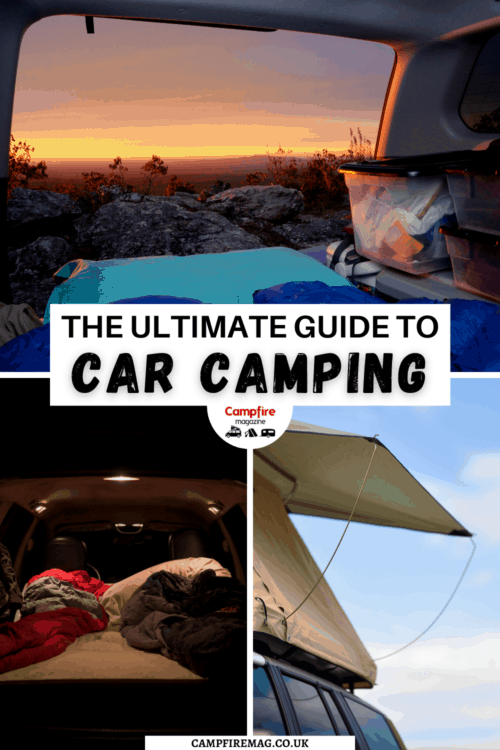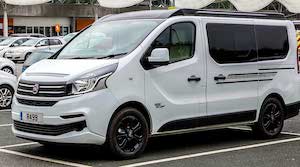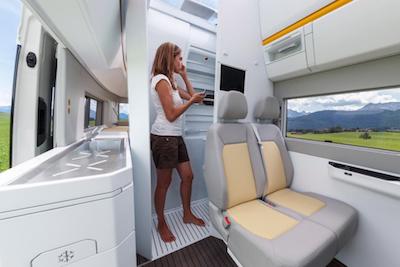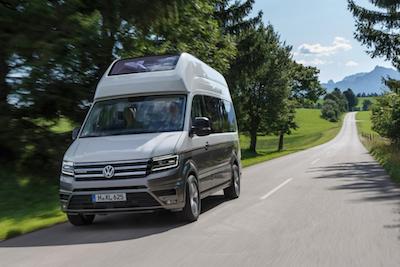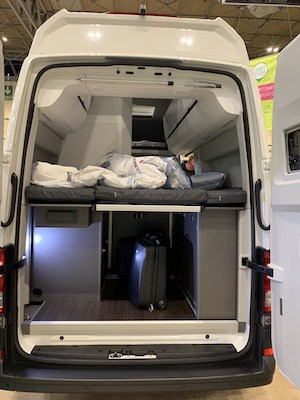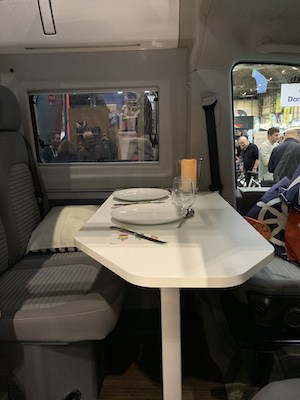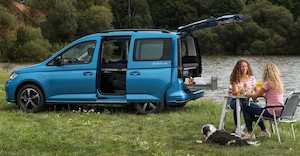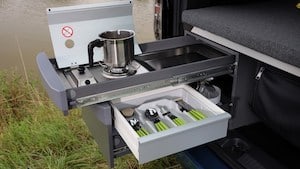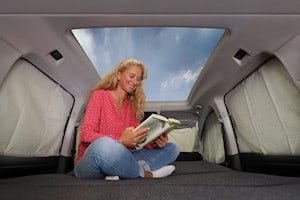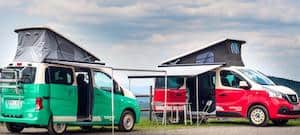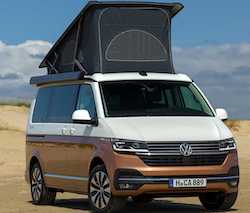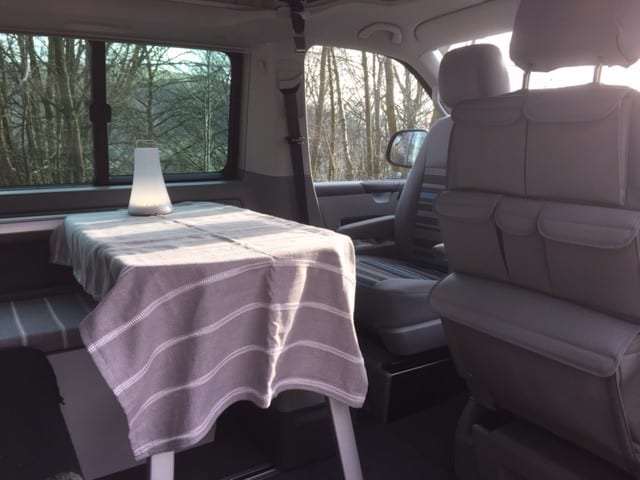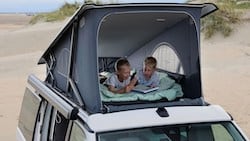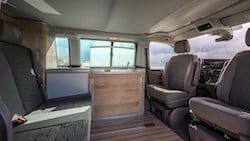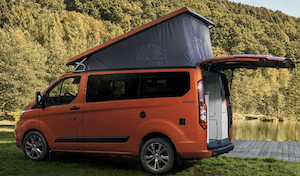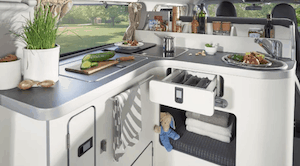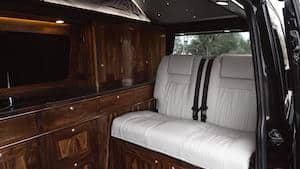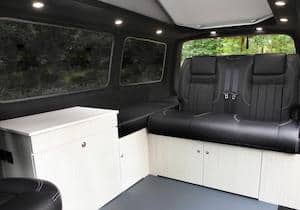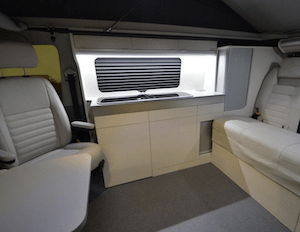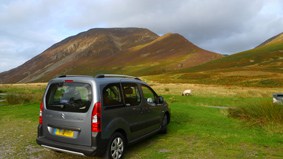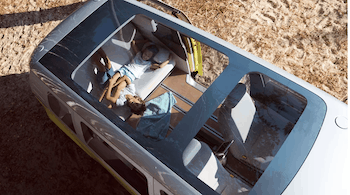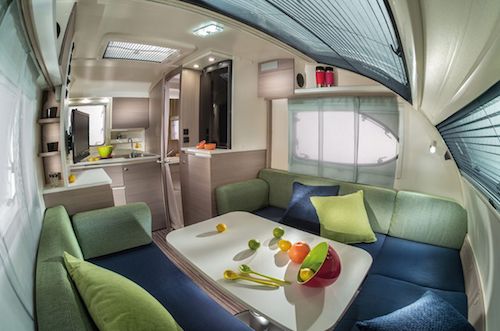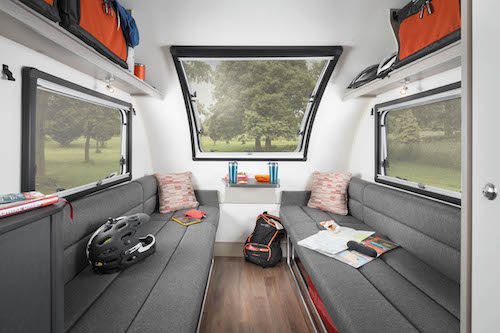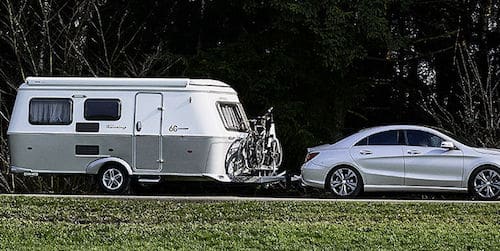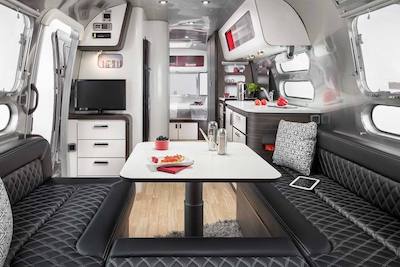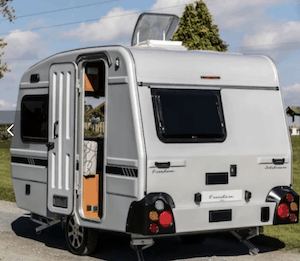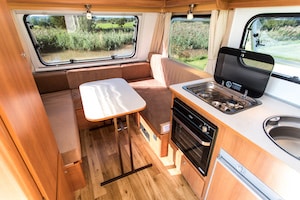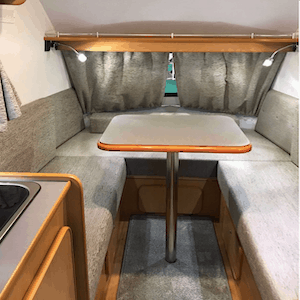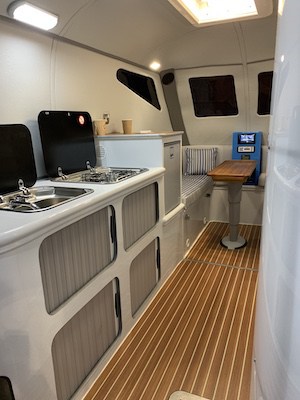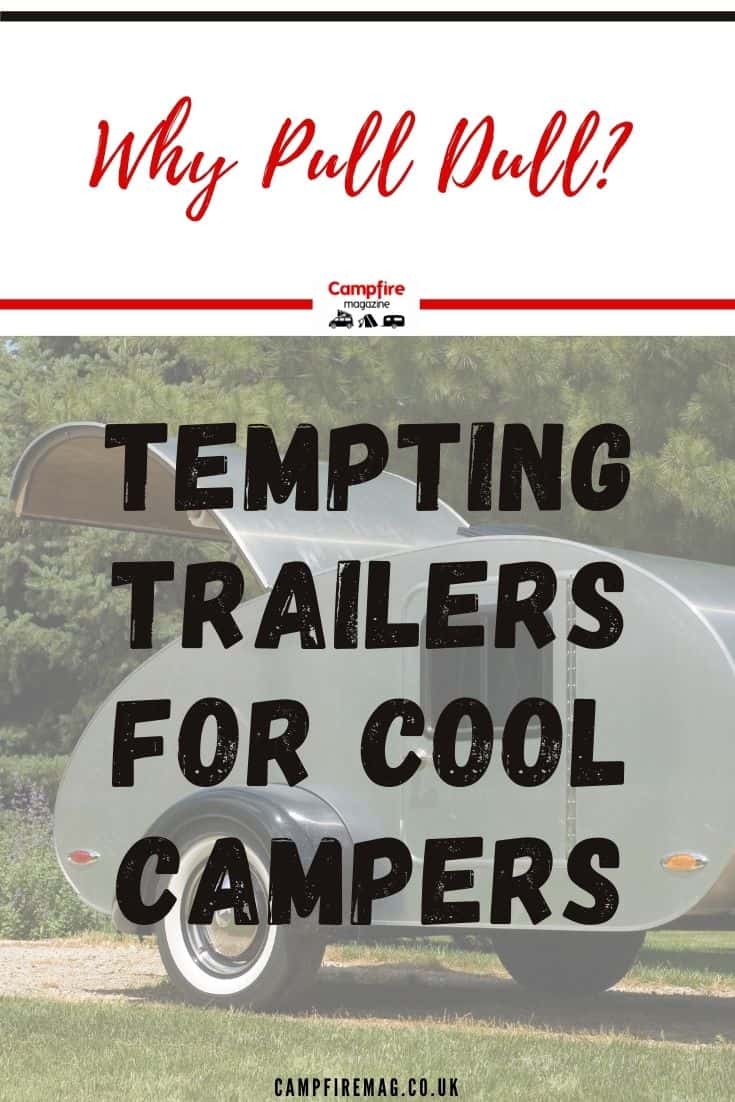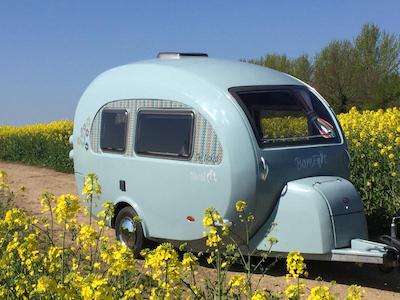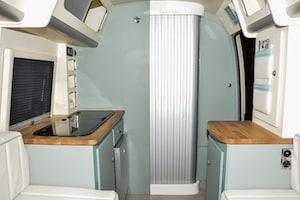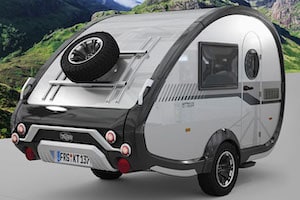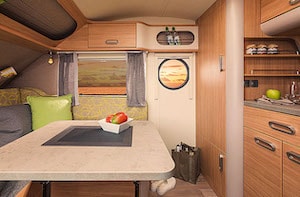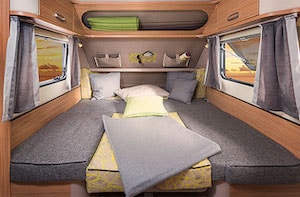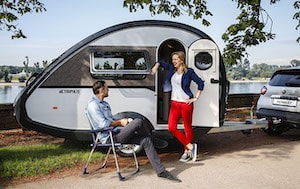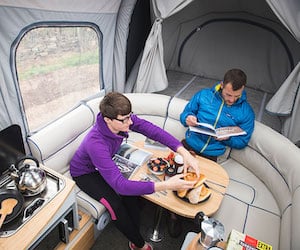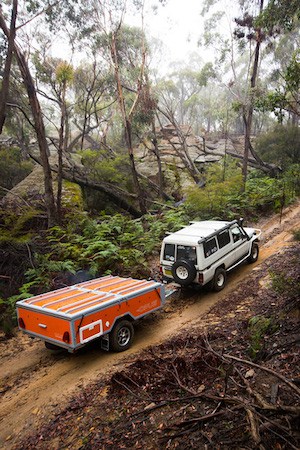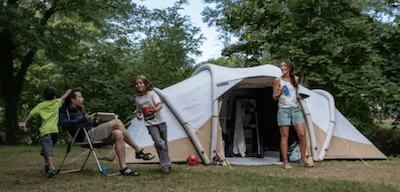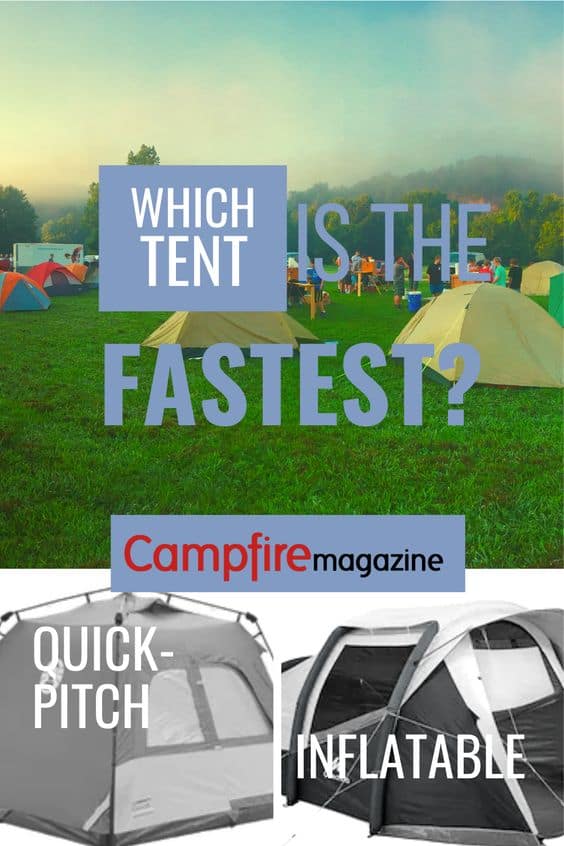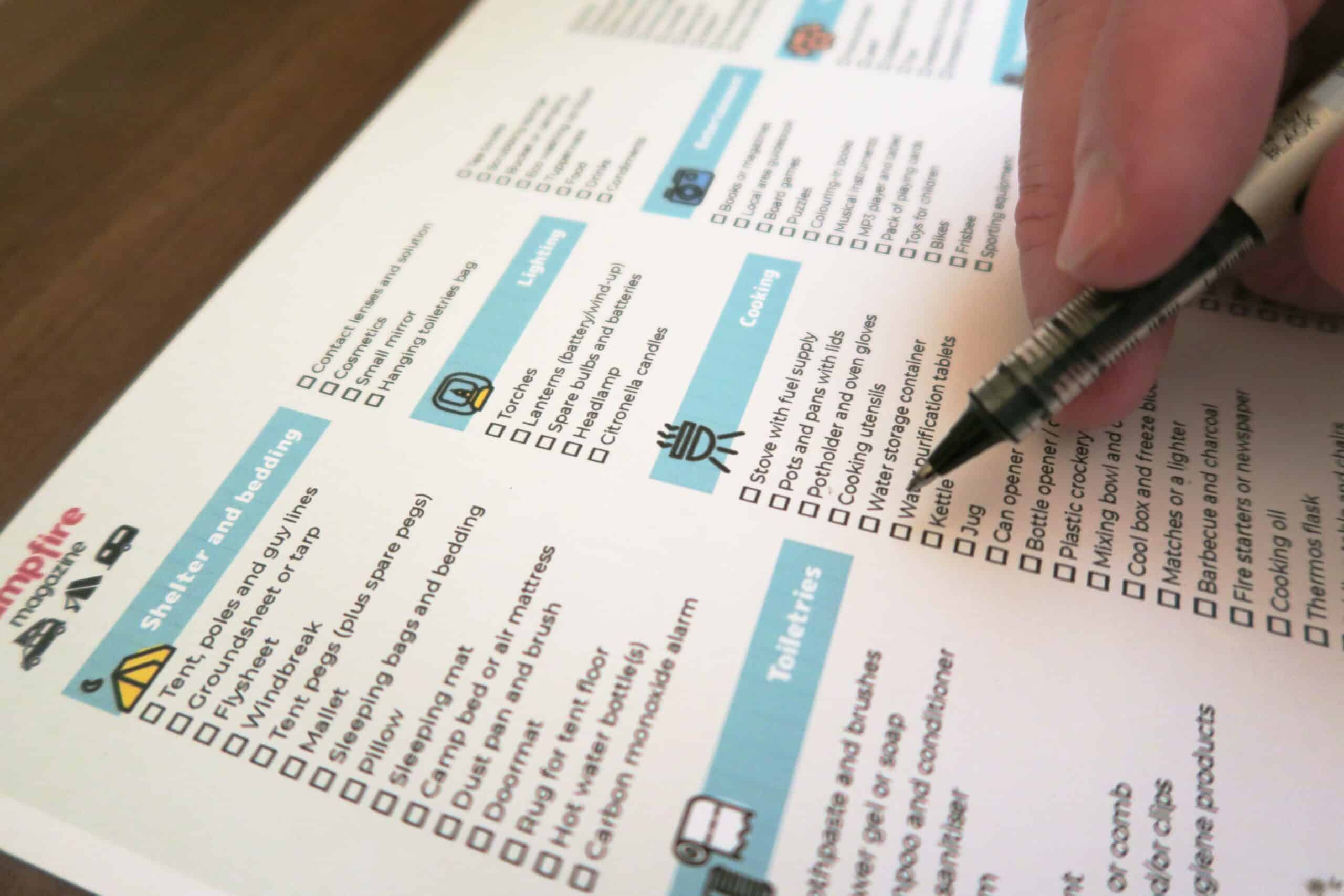What’s new and wonderful in the world of campervans and compact caravans?
We’ve looked at lots of new vans, mini caravans and camping trailers and come up with our favourites – and some not-so-greats – to save you the slog!
All our reviews at Campfire Magazine are independent and honest.
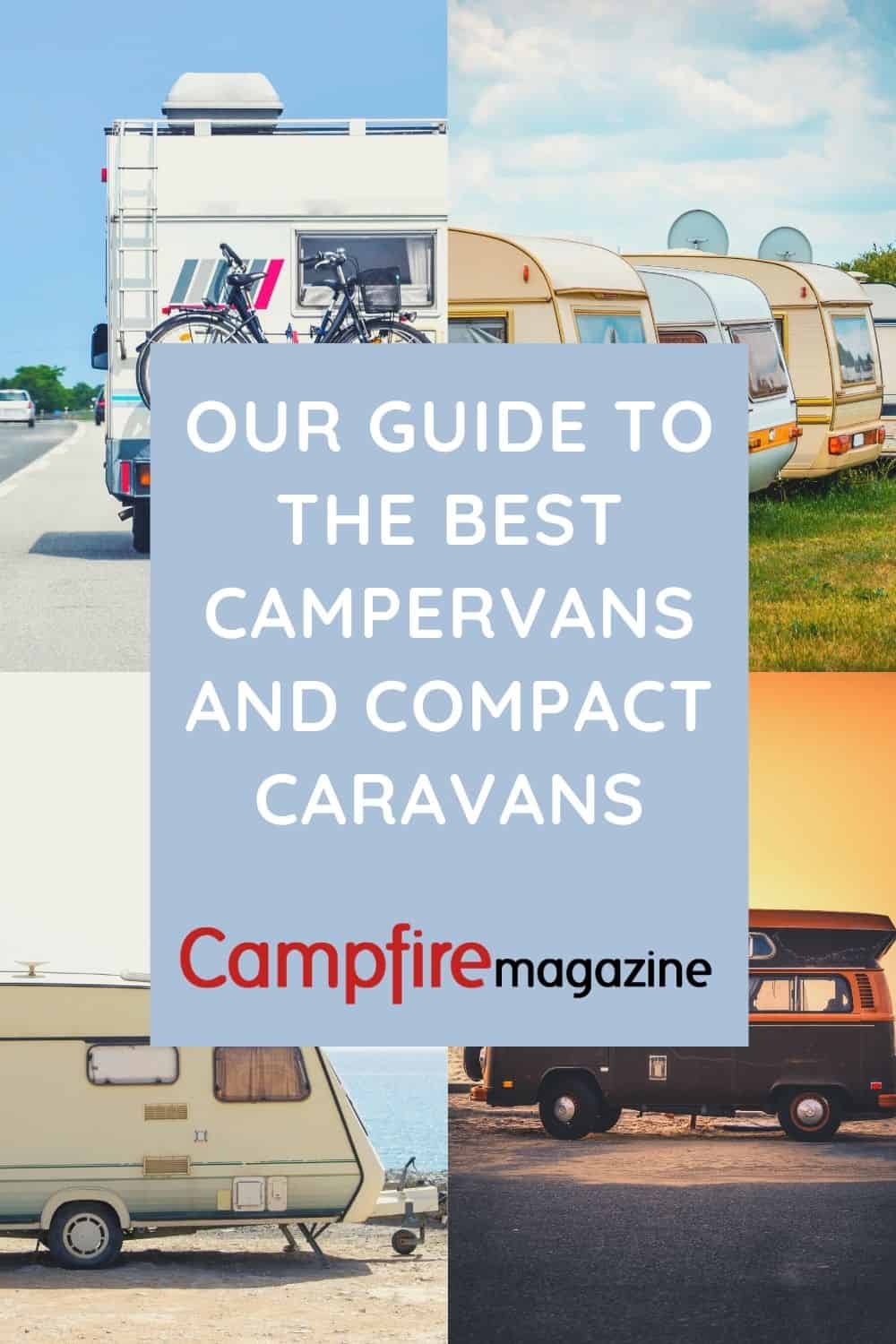
New trends in campervan design
The CMC HemBIL
Urban has narrower units down one side and the cooker unit comes out completely.
Last year, we reported a new trend in removable fittings. We’re still seeing a number of new models with modular units – basically, you can take out things like the cooker unit or the storage to make the van more versatile. It’s why the California Beach has been so popular with owners.
Jerba’s J-Pod
Lots of manufacturers are now making campervans with removable furniture so that you have more options for how you use your van. Where you put the cupboards and bed and kitchen pods when they’re out of the van is another question!
Three Bridge‘s Multivan pod
Three Bridge make a Multivan option with a solid removable box.
Jerba’s J-Pod offers four different configurations of full campervan layout, family car, awning living (with outside service connections) and a half-in-half-out set-up.
Auto Campers‘ Day Van (based on a Tourneo) is highly customisable for camping and anything from carrying bikes to work tools to show dogs.
Rising roof design has changed a bit too. We saw lots with unzippable sides so that you can have a virtually topless campervan.
We saw panoramic one on the Rolling Homes range and on lots more. The roof canvas has a zip around the front section that allows you to convert the van into an open-top (more or less). Fantastic for hot climates.
Jerba
Jerba has gone a step further with a removable canvas. The idea is that it can be cleaned and repaired more easily.
Where did the roof go? Jerba‘s removable canvas pop-top
Bilbo
Bilbo’s campervans are all about solid interiors and functional space, but we also like their side rising roof, which looks neater and more sturdy. It will definitely be a clincher for some, but check head height over the kitchen area if you’re tall.
We are always on the look out for the best motorhome accessories and gadgets, here’s our current guide
Oddly, we saw fewer models this year with twin opening doors, but it is something that we like because it makes the van seem to spacious. It’s practical too.
Auto Campers‘ twin doors
As well as making the interior of the van lighter and airier, it’s easier to keep cooking smells at bay and gives you more options for chatting with the family when they’re outside.Hembil
We liked the Hembil swing-out kitchen in their Drift model and it made the rather functional-looking interior make a lot more sense – a van for being outside doesn’t need to look like a 1990s hotel inside. It was interesting to see how many people at the last show pressed on it to test its weight-bearing ability, though. Lightweight bamboo plates rather than cast iron, maybe!
Inside kitchen, outside kitchen
Auto Campers, for example, have designed their award-winning MRV with two opening sides, one of which reveals a kitchen that can be used both from inside and outside the van.
Rolling Homes are another opting for twin sliders. Designing that inside-outside cabinet is a tricky business and some do it better than others.
There’s a height-issue when you’re standing outside and the units are built from van floor level. Some attach a fold-down table or pull-out to make better use of the outside space. And it needs to look as good from both sides – you don’t want to be looking at the unfinished back of a kitchen unit.
The Westfalia Jules Verne campervan. Love the doors, hate the impossible cushions.
Miraculously, more and more Transporter-size campervans are getting toilets (and even showers). The trade-off is living and sleeping space, of course.
Jules Vern
Jules Verne again. A stunning loo and shower but it’s cramped up front.
We prefer our bucket and to keep a few thousand pounds for something else, but we heard a lot of people impressed with the idea of being able to choose pitches further away from toilet blocks. And, of course, it may open up more opportunities for people who’ve been put off wild camping.
If you don’t fancy spending £60,000 on a van with bathroom, have a look at our articles on portable camping toilets and camping showers.
New trends in compact caravans and trailer tents
T@B’s Mexican Sunset mini caravan
The main change this year is that the price difference between campervans and caravans looks starker than ever. The average price for a small caravan seemed to be around £18,000 while the average campervan was £50,000.
TransCamper mini
If your campervan is your only car, then the difference is mitigated a little, of course.
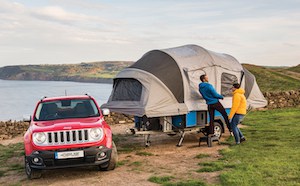
On trailer tents, nothing very new apart from a move to off-roadiness, and our favourite still stays our favourite by a long chalk.
And you should see the inside, the off-road version and the price!
We’re always on the look-out for new discoveries, getting nosy, clambering in and out of everything and chatting to owners and manufacturers. So, do keep following us on Facebook.
Which campervan should I buy?
If you’re looking for a brand new campervan or caravan, all the manufacturers and converters bring their star models to the shows.
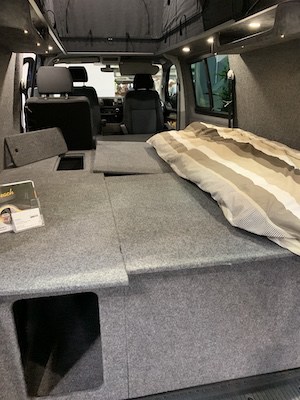
My worst nightmare (after the bizarre one about Les Dawson). Grey carpet everywhere.
You can choose designs that look a little like hospital or office interiors with grey cupboards in preponderance and grey carpeted walls, or something that aims for difference with splashes of lime green and orange and a zillion LEDs.
This year, happily, it seems the world’s supply of grey carpet might finally be drying up. There were certainly some more interesting and attractive ways of lining the van conversions with just a peek of carpet here and there even in some of the top end models.
Take your pick of interiors
Don’t be won over (or put off) by the colours and finishes on show. You’ll usually have a choice. DO look for clues to good or bad work and attention to detail.

We never want to see a brown plastic catch like this inside a £65,000 van.
Look at the details
With new vans starting at around £35,000 and more likely to cost well over £50,000, you need to be picky. And we certainly are
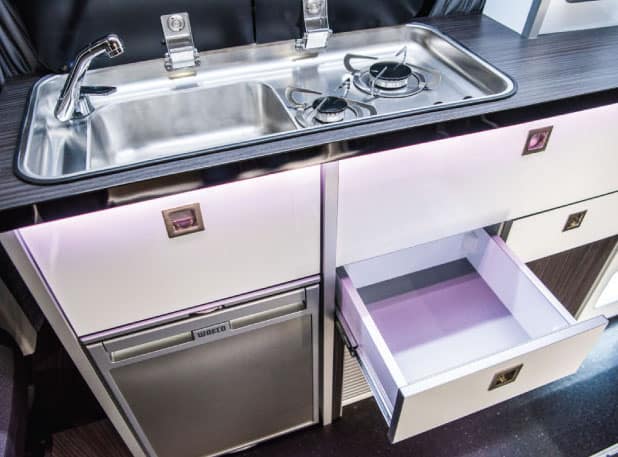
Behind the swank and glamour, check the drawer fittings and the details. Too often, we find screwheads on show, sliding cupboard doors that don’t slide and odd bits of gubbins that should be behind the scenes rather than visible.
Take the stunning Westfalia Jules Verne, for example. This 60th anniversary model costs around £64,000 and has one of the smartest interiors we’ve seen, including a shower/toiler room too. But open the cupboards (using the fiddly catches) and you’ll find cheap plastic fittings. And visible screws in the lovely floor.
Screwholes and flooring
The Volksleisure model we looked at, for example, might win you over with the company’s logo woven into the carpet and the sleek fittings, but look a little closer and you’ll see unfinished screwholes and doors that stick and bend.
Reimo attracted us with some clever layouts and a pull across flyscreen on the sliding door, but why not spend some of the £45,000 your customers are giving you by finishing off the inside of cupboards properly?
Watch out too for their floor channels on models that have a sliding bed – they’re wide, deep and unprotected by a brush strip, so will soon jam with dirt and gravel.
Buying advice
1. Look for build quality and attention to detail.
2. If you don’t like the mock leopard-skin panels or beige seat covers, chances are the manufacturer will let you choose from lots of different finishes.
3. Make a list of your must-haves – passenger seats, types of roof, parking heater, size of bed and so on.
4. Go armed with a list so that you can compare models and prices from the same basis.
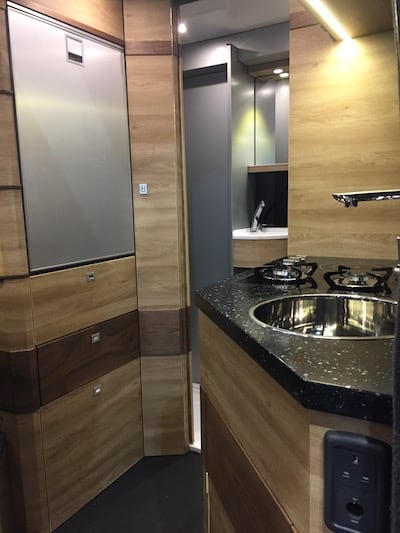
Inside the Hillside Leisure Crafter
Although we aimed to look at campervans no bigger than the VW T5/6, we did have a peek at Hillside’s Heatherton Crafter-based van. It costs around £60,000 and is the size of a small motorhome.
They’re rather hefty beasts on the outside, but what stood out about the Heatherton was the unusual interior – crafted wood in a stylish design with a smart kitchen area, toilet and even a shower.
Shame about the internal plastic fittings in the cupboards, the white plastic window frame and the rather difficult to use pop-out doorknobs, but there we go again with our pickiness. For someone feeling constricted by usual campervan sizes but put off by the size or weight of a motorhome, then this will be tempting.
On balance, we preferred the Rangder – the R535 (5.4m long and 2m high, with a loo and small washroom.) and R499 (4.9m long, 2.03m high) options. They’re built on the Fiat Talento (replacing the Scudo) and start at around £42,000.
Inside the Rangder
Solidly built and very well-equipped, if a little unadventurous inside, they should attract people who want a more motorhome feel but still want to be able to park at the Co-op.
While there was a queue to see inside VW’s Crafter campervan, the Grand California. reactions were mixed.
It comes with underfloor heating, a bed that can be heated and cooled, a retractable wet room, chemical toilet, full kitchen with hob, sink and fridges, plus a living and dining area. Much of the technology on board can be controlled via a tablet or its own app. This includes controls for the lighting, music and opening and closing the panoramic roof.
Up close, it’s VERY tall and, I have to say, a bit of a squeeze inside. Everything is flush and ingeniously arranged. I’m sure there will be some niggles after spending time on the road and campsite with it, but that’s true of any van.
We did find the living/dining area possibly a bit small for a family, and the side kitchen over the side door means there’s no lounging around sitting on the threshold of the wide open door of the Ocean or Beach. Prices start at around £70,000.
This, however, is a motorhome, and I wonder whether anyone in the market for a small MH wouldn’t be better looking at some of the top-end coachbuilt options. If you’re a California fan, though, nothing will put you off!
Mini campervans
For around £30,000, you’ll soon be able to have all that VW California neatness in a small campervan. But is it worth the money?
The new California version has the advantage of a big glass roof to liven things up, plus California accoutrements such as built-in table and chairs, blinds on the windows and a neat pull-out kitchen under the tailgate
Before we bought our campervan, we did look at the standard Caddy as a possible workaround. What put us off was the low driving position (compared to Transporter-sized) and a rather hearse-like feeling inside.
The factory-built campervan version would definitely have tempted us and we can see there being a lot of fans!
A few companies convert the VW Caddy. These won’t be as neat as the factory-built California Caddy, but the advantage is that you can customise to your needs.
There are, though, some odd-looking designs out there in the attempt to squeeze everything in.
CMC do a Caddy starting at under £25,000 with a fairly neat layout. Some of these smaller models tend to feel dark inside, but this one avoids the problem.
Hillside make the Dalbury, based on a Nissan NV200, for around £30,000.
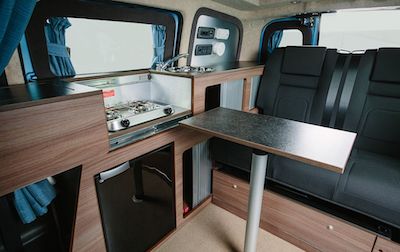
You might want to keep an eye out for Nissan’s own NV200 and NV300 campervans, which include an electric model. They’re not available in the UK at the moment, but in Spain (where you can buy them), they’re some of the cheapest vans we’ve found and come with lots of options for specifying your equipment.
With campervans this small, have a think first about whether your own car could work for camping. Have a look at our article on car camping for ideas.
The VERY best campervans
No surprise that our first choice would still be the VW factory-built California Beach (for those wanting a versatile campervan for daily use) and the Ocean (for the full kitchen experience). Read on for our other favourites this year.
1st Place
The appeal of the California is that it comes off the VW production line as a campervan. None of that cutting off the top with an angle-grinder and lining the sides with carpet! I
t’s fabulously well-designed for cooking, storing, sleeping and sitting, and it looks more contemporary than many of its rivals.
A new T6.1 Ocean starts at around £60,0000, and the new Coast (a lower spec version of the full campervan) at around £50,000. Preloved ones retain value well. Sadly, you can no longer buy new Beach models in the UK. There’s more on that at the end of this section.
Inside a VW Beach – no kitchen, just lots of versatile space
The Californias have some beautifully clever touches, such as the stowaway outside table and chairs and rounded edges on the fixtures. The camping chairs in the tailgate, by the way, are the comfiest we’ve found for eating and relaxing.
On the negative side, after the cost, the interiors can feel a little fragile – perhaps the preciousness would wear off over time. But the same is true of all campervans – complex beasts that they are. You want to be able to use them, carefree!
The new California T6.1?
Not enough substantial change to merit a T7, but there are details that existing or previous owners will like.
Comfier beds, cupboards and storage units with better latches and handles, positive catches on the lids for the hob, sink and fridge. A touchscreen unit to control the camper-specific features has been added with details of battery charge, water tank capacity, heating and lighting and even spirit-level.
The Multiplex board (parcel shelf) is now a modular platform that can be raised, lifting the head of the bed for lounging. The roof canvas is darker for sleeping in after dawn!
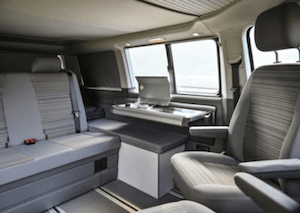
The T6.1 Beach comes in a Camper and Tour version, the former with an ingenious fold-out kitchenette.
The Beach has long been our favourite for its versatility. The new 6.1 models start at £52,000, so you might want to snap up a secondhand one…NOW!
2nd Place
When we stopped laughing at the name, we were very interested to see Ford’s own campervan, a new partnership with Westfalia.
The Custom Nugget, based on a Transit, has a weird interior layout that we disliked at first sight and then started to warm to.
The rear kitchen is separated from the living/cab area, which seemed a bit sad for the cook. However, the logic of the layout started to dawn after a while. Because the kitchen is at the rear, you can stand upright in it even when the roofbed is down. That’s because the entry to upstairs is from the back, using a neatly-stowed ladder.
The other bonus is that the UK version has twin sliding doors. The living area feels a bit cramped but with both seats swivelled, it’s very useable and you get extra width that would normally be taken up with a side kitchen.
From £56,000 to £58,000, depending on engine size as there’s just one internal specification. It’s definitely one to look at more closely when models become available.
Joint 3rd Place
Choosing a campervan is absolutely subjective.
Personally, we like space, light and the feeling that you can use the van without worrying too much about it. Others like stunning interiors and all the mod cons. And, of course, price is a big factor too.
So, we’ve actually chosen two for third place.
For build quality, the best campervan converters are Rolling Homes and Three Bridge. Top-class materials and craft in their more expensive models.
This is the Rolling Homes 10th Anniversary model at £118,000, stuffed with gorgeous walnut cupboards that wouldn’t be amiss in a mansion.
Rolling Homes’ vans start at under £35,000, are totally customisable and they make an Abiilty model for campers with disabilities and a versatile Weekender.
No-one beats Three Bridge for style. This is their Infinity look. Conversion prices range from around £13,000 to £40,000+
The Three Bridge Tourer. We also like their Multivan for modular options. Everything is customisable.
4th Place
Testing out a Berlingo stealth camper on the Honister Pass.
Maybe it’s time to consider a homemade option?
Have a look at what you can do with just a Berlingo people carrier and a few hundred pounds, for example (as basic as it gets!).
Cheaper still…have a look at our article on how to camp in your car.
The future of diesel campervans?
From 2035, there will be a ban on the sale of new petrol, diesel or hybrid vans in the UK. That’s the plan anyway.
So with just 15 years to go, what does that mean for campervans and motorhomes? One possibility is that sales will go up now as people decide to realise their camping dreams earlier on.
Manufacturers, though, are getting worried because they rely on base vans from Volkswagen, Fiat and so on, and these – apart from one Nissan electric – are all diesel-powered.
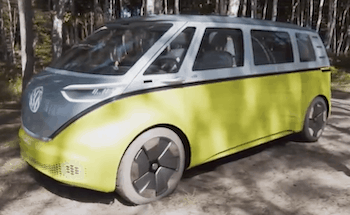
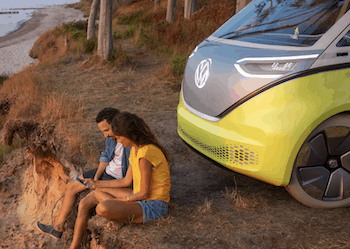
VW’s concept SUV/campervan, the ID Buzz, is at least two years away. It’s actually quite akin to the Beach in its versatility. However, the problem is not so much the availability of electric campervans, but more the availability of charging points.
Fine if you’re tootling round town, but that’s not how most people use their vans. How will we tour long-distance in more remote and rural areas?
Obviously, tackling the climate crisis takes priority over people having a few nice holidays. So, we’re hoping for some effective solutions over the next 10 years. That’ll come partly from us campervanners rethinking our trips and putting some effort into handling the necessary changes. And we’re hoping especially for some serious investment in electric-charging, better batteries and vehicle design.
Read our article on Electric Campervans And Motorhomes
The most interesting caravans
We didn’t look at any of those big white boxes and turned our attention to compact caravans that are more likely to compete with campervans. If you’re still wondering which would be best, take our campervan or caravan test.
The retro caravan craze has led to lots of new rounded shapes with amazing space inside. Unlike many of the campervans, these often have stunning interiors. Here are some of the best we found. For the VERY best, see the next section.
Adria Action (wide angle turns this mini caravan into a palace, eh!)
Adria has got in on the retro styling act with their Action Choice. It’s actually not a small caravan at all – unlike the Barefoot, T@B or GoPod, for example, but it has the same curved styling.
The inside, at first glance, looked a winner, till we watched someone open the sleek drawers to reveal a dodgy plastic catch (see the section earlier) and the evidence that attention to detail is only surface-deep. Still, it was great for space, very light-filled thanks to the panoramic window and well-specced.
It costs around £18,000.
Hymer’s Eribas are lovely things, and their 60th anniversary model has the GT pack of silver finish, alloys, external storage and other bonus features. Prices are from £18,500 to £24,500 (plus delivery from Germany) from the tiny Touring upwards, but all amazingly spacious inside. They’re well-made and hold their value. You get to sleep in a big bed and use a proper kitchen. Ones from the ‘80s are still going strong.
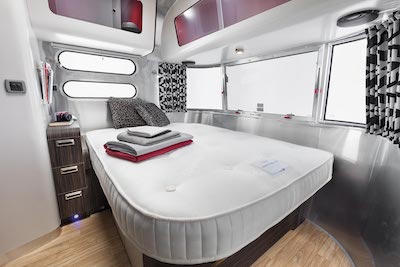
The Airstream, as you might expect, takes the prize for beautiful interiors and exteriors. The smallest, though (the single axle Missouri) cost £79,000 upwards. People are buying these now to plant in their gardens for use as a home office, but the same is true of our under £25,000 favourite too!
The cheapest ‘proper’ caravans (ie, fully equipped) are the Freedom, and these are a peculiar breed. Retro outside and retro (in a bad way) inside as though they’ve been found stockpiled from the ‘80s in a hangar somewhere. Cheap and light, though. A choice of five sizes and specs from around £11,000.
The very best caravan choices
We love the Barefoot. It’s a beautiful, small-but-perfectly-formed combination of retro and modern.
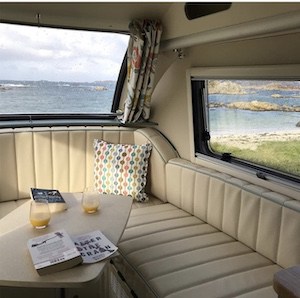
It’s not flashy, just well-designed, well-built, easy-to-use and remarkably spacious. £24,000 will buy you a fully fitted model with shower-room and great kitchen, but you can also buy a £16,500 Space version with basic fitting that could also be used as a home office and so on.
The inside styling and attention to detail is something a lot of campervan companies ought to copy.
T@B caravans started life at the Tabbert Caravan factory near Frankfurt in Germany. They have aluminium insulated shells and the build quality is superb.
Lightweight, manoeuvrable and with a choice of two sizes and five designs, including the off-roader shown above, they’re a great choice.
Prices start at just over £12,000, but there are lots of extras you might want to add on.
Have a look at our feature on vintage caravans too.
Trailer tents
Our Why pull dull? article is a great round-up of all the unusual trailer tents and caravan hybrids out there. And our winner, by a wide margin, is the utterly fantastic Opus.
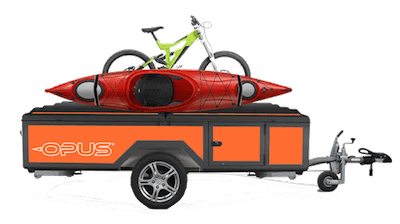
Many trailer tents are so enormous and complex (Conway, for instance, is like a bungalow in a box) that you may as well buy a caravan and not have all the setting up to do. Others are nice and small for towing, but fold-out to little more than a tent.
So, why the Opus? Well, for its looks, its ease-of-opening, its build quality, its spaciousness and its all-round versatility. Price isn’t bad either (£13,000 to £21,000).
In appearance, it’s a mix of safari tent and sci-fi – airy, spacious and with options and accessories to suit family size (four- to 10-berth) and your camping and outdoor life.
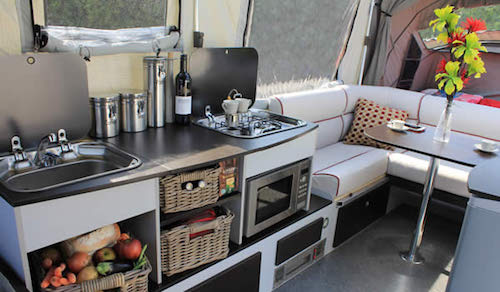
The kitchens are beautiful, the beds comfortable and the sitting/dining room made for socialising. What’s more, the Air Opus inflates itself in two minutes. It’s lightweight and low-profile and the racking system means you can load it with bikes, kayaks and more for your travels.
The latest is an off-road model with a great oull-out stove and coolbox, which means you can stop for a picnic lunch without putting up the main structure.
A stand-out favourite once again, but do have a look at the other trailer options too, though!
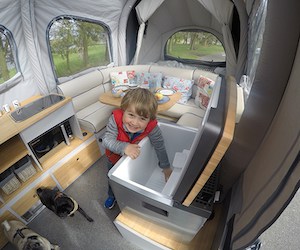

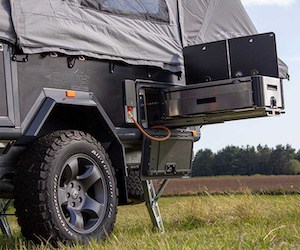
What about a tent?
Camping is fabulous – the being outdoors, the ineffably happy-making things like the routines you get into, chatting to people in campsite washrooms and the simplicity of it all.
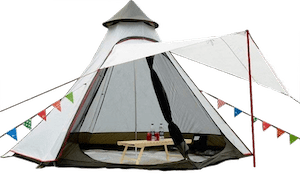
But for some, there comes a point when the pleasure-pain balance of camping tips just a little too far to the negative…all that faff and the making-do. It’s not surprising, then, that a campervan or caravan starts to look like the best of both worlds. You’re still camping, but you’re sleeping off the ground and bad weather isn’t a problem.
The downsides? Well you could end up with two vehicles instead of one, or something heavy to tow and store. Then there’s the cost, the depreciation, the cost, the cost. So, if you’re still thinking tent…
One of our favourites is the Coleman’s Cortes Octagon tent, for having a real, hinged door. It can also be used as a screenhouse/gazebo without the inner tent and looks cool. There’s a new blackout version too for those who like a lie-in!
But there are some simply lovely new tipi-type tents around that are surprisingly easy to put up and have lots of space. Have a look at all our favourites – inflatable, tipi, bell, quick-erect, pop-up and more.
Our favourite easy-to-pitch tents
One central pole to pitch and you have a 4m diameter tent with a 2.5m central headheight. Weighs under 10kg and sleeps eight.
Look at this pale, interesting and VERY affordable Air Seconds 4.2 XL tent, which won the 2020 Best Value Family Tent award. It has great blackout bedrooms, plus a zip-out groundsheet.
The latest model has a great shape for maximising inside space. Same features in that it can be used as a shelter or as a tent.
200 x 180 x130cm (H),packs to 75 x 18 x 17cm and weighs just under 3kg.
The Coleman Octagon is our favourite poled tent. Its gazebo-like structure makes it versatile and airy.
There’s now a new blackout version too, though this is a bit more expensive.
Frequently Asked Questions
Which is better caravan or campervan?
Both campervans and caravans are great for your next vacation. A caravan is a trailer pulled by a truck or van that can sleep up to 10 people, while a campervan is the "caravan" on wheels with beds in the back. They come with all of the amenities you would need like fridge, stove, sink, bathroom etc.
What's the difference between a campervan and a motorhome?
The difference between a campervan and motorhome is really just where you’re sleeping at night. A campervan has a large living area with beds, called bunks, that are built in to the back of the van for passengers to sleep on. There is usually no kitchen inside of it. The driver sleeps outside in their own bed or hammock next to the vehicle while cooking meals on an outdoor stove or grill. While a motorhome has everything you need inside! There's room for all your friends and family as well as storage space for food and other camping gear like tents, chairs, tables and so much more! It's usually equipped with a toilets too.
Are campervans worth it?
Traveling in a campervan is an affordable way to see the world. The price tag may be low, but with that comes some sacrifices. These vehicles are not for everyone, so it's important to consider your needs and desires before making a purchase. Some of the pros include: more space than a hotel stay, no need to worry about luggage weight limits or long lines at check-in desks, ability to cook meals on-site if desired, and you can sleep comfortably without worrying about disturbing other guests. On the flip side, there are cons too: limited storage space (think suitcases), less privacy than a hotel room since you share one with others in your vehicle group, usually does not have facilities like laundry or showers.
Why are camper vans so expensive?
There are many reasons why camper vans can be so expensive. Some of these include the cost of conversion, the size and weight of a camper van, and how much work is needed for a conversion. There are also different types of conversions that will affect the price.
Inevitably, all these factors come together to make up an individual's total costs when purchasing their own camper van. Ultimately it comes down to what they want in their vehicle and how willing they are to pay for it; some people may need more space than others or maybe have more money available to spend on their purchase. Either way there is nothing stopping anyone from enjoying a fun filled road trip with friends or family!

